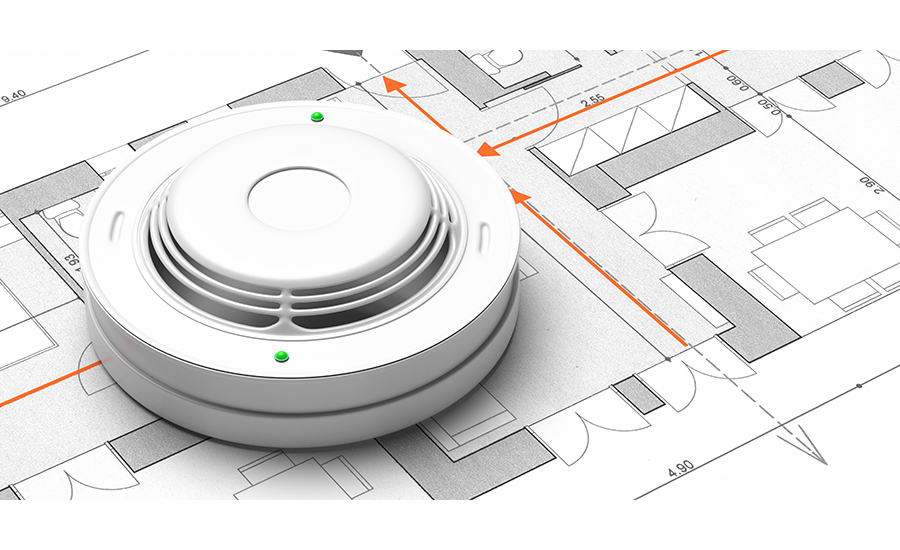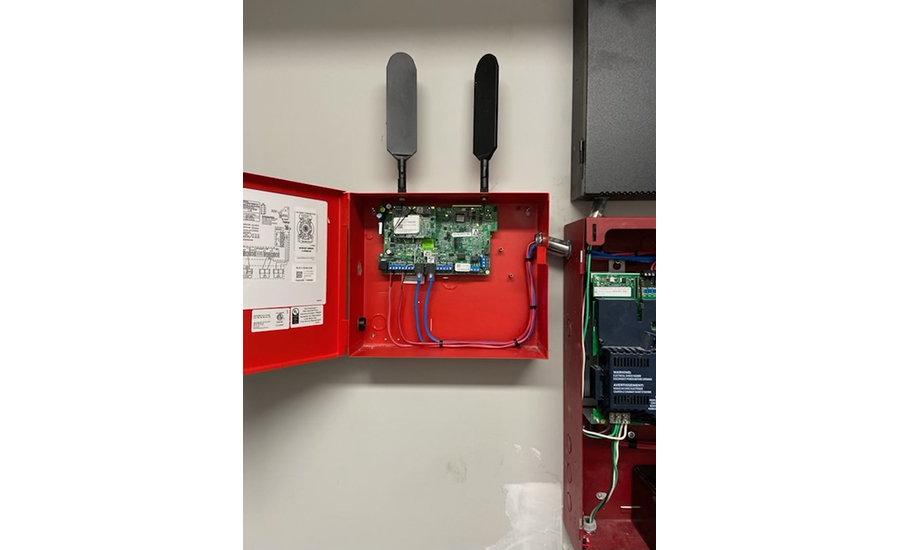The fire and life safety industry is heating up with increasing opportunities for fire alarm contractors to advance into new territory. According to the Grand View Research Fire Alarm and Detection Market database, the global fire alarm and detection market size was $29.8 billion in 2021 and is expecting a compound annual growth rate (CAGR) of 7.2 percent on through to 2030.
North America emerged as the largest regional market in 2021, according to San Francisco-based Grand View, accounting for a revenue share of around 40 percent. The expansion is attributed to more stringent fire and building codes for industrial, commercial and residential occupancies; the use of addressable systems and technology advancements; fire and life safety awareness; and existing occupancies being brought up to compliance during additions, renovations and maintenance.
Ahead, we explore fire alarm industry growth factors — including recurring revenue opportunities — with subject matter experts from the manufacturing community and National Fire Alarm Protection Association (NPFA), along with a look at the latest in code compliance essentials and profitability best practices.

As of January, NFPA 72 requires smoke alarms and detectors within 20 feet of cooking appliances be listed for resistance to common nuisance sources from cooking // RAWF8/ISTOCK / GETTY IMAGES PLUS VIA GETTY IMAGES
Recurring Revenue Creation
One of the most significant developments in fire alarm control panel (FACP) features and the life safety industry as a whole is revolutionized notifications, explains Rodger Reiswig, fellow and vice president of industry relations, Johnson Controls, Milwaukee.
“When a fire or other emergency strikes, the No. 1 priority is alerting people to danger and guiding them to safety. With sophisticated engineering to enable exceptional performance and reliability, innovative fire alarms can help ensure orderly evacuations and protect lives,” he says.
New technology combines emergency messaging with easier, more efficient design and installation, and dealers can fine-tune each system to the unique needs of each space, Reiswig continues. “With increased customization and the ability to not just detect, but communicate emergencies, the benefits of installing an innovative fire control unit increase, creating more opportunities for recurring revenue and meeting the evolving needs of customers.”
Daniel Rosales, senior director, technical services for Atlanta-based Telguard, explains it is universally accepted that system enhancements and improvements are always limited by two factors: technology and accessibility to that technology.
“For decades, FACPs have been bound by the limitations that come from relying on POTS as the main means of communications. With the evolution of other technologies like cellular and internet, there are a whole new set of opportunities that are now open for the savvy integrator.”
— Daniel Rosales, Telguard
“For decades, FACPs have been bound by the limitations that come from relying on POTS [plain old telephone service] as the main means of communications,” he says. “With the evolution of other technologies like cellular and the internet, there are a whole new set of opportunities that are now open for the savvy integrator.”
Rosales adds there is of course the opportunity to replace POTS, which generates money for a phone company, with an alternate pathway like cellular, which generates money for the dealer instead. But there are also new features being presented by FACP manufacturers that take advantage of the opportunity that alternate communication pathways bring to the table.
“Whereas with POTS there was a limitation on what information can be sent and/or received, and restrictions created because of the time it took to deliver any data to/from using POTS, nowadays with cellular IP there is more accessibility to delivering more data, faster,” he says.
Rosales further explains, “Systems that leverage that communication path to build a cloud infrastructure that gives more access and more information than standard panels that just deliver signals to central stations, offer an opportunity for extra RMR based on those cloud-based features.”
Craig Summers, vice president of sales for St. Louis-based Potter Electric Signal also emphasizes the limited ability for legacy fire alarm systems to supply information external to the system itself and the central station.
“The shift from POTS lines to cellular and IP communication has opened doors for fire alarm installation and service companies to offer additional RMR generating services to their end users by providing more detailed information, while also providing cloud-based services that enhance the ability of a technician to install, troubleshoot, service and test systems,” he says.
As an example of this type of innovation in the industry, Summers cites the new Potter IntelliCom Gateway. In addition to central station communication, it offers a host of services that dealers can leverage for additional RMR. Potter panels integrated with IntelliCom can facilitate central station communication, automatic panel program backups/retrieval, remote system programming, cloud storage and mobile walk tests that generate an NFPA 72 initiation device report.
“Additionally, all system activity is accessible via mobile devices or computer browsers, providing building managers and first responders with accurate information in a timely manner,” Summers says. “Such services not only increase the safety of the fire system, but also create an RMR revenue stream.”
Technology Advances Fire Alarm Opportunities
FACPs are seeing major advancements with the incorporation of technology, says Shawn Mahoney, technical services engineer for the National Fire Protection Association, (NFPA), Quincy, Mass. The ability to connect systems using the Internet of Things (IoT) is redefining fire alarm and signaling systems. The latest editions of NFPA 72 include the development of Class N pathways, which permit the use of dedicated network systems and infrastructure for fire alarm and signaling systems.
“The biggest trend we’re seeing is that everything is becoming more and more connected. Connecting fire alarm systems to the internet allows for remote diagnosis, remote testing, remote changes to programming and more,” Mahoney says. “However, this increase in connectivity requires new code requirements to ensure systems are secure and operating as designed. Remote access is a new requirement for designers to consider because users can now access a fire alarm control unit remotely to test, make software changes or run diagnosis.”
Mahoney points out the latest edition of NFPA 72, National Fire Alarm and Signaling Code, holds requirements on how that needs to be done in a manner that’s both secure from a cybersecurity standpoint, as well as ensuring that the system still operates as intended even if someone is accessing it remotely.
“For the 2022 edition of NFPA 72, designers are required to consider the cybersecurity of the entire system as well if required by other codes and standards,” he says. “A new chapter has been added that talks about cybersecurity, and an annex was added that provides a list of items to consider when looking at the security of a system.”
Conventional FACPs are increasingly user-friendly and designed to meet a variety of customer and building needs, Reiswig explains. New, addressable control units can pinpoint the source of a fire, life safety event, trouble or other system event while offering a modular design and intuitive design.
“One particular area that is ripe for growth is low frequency sounders and LED technologies to meet the needs of those who are deaf or hard of hearing,” he says.
Reiswig further explains, “LEDs and some strobes are good for people who may struggle to hear fire alarms, and low frequency sounders in sleeping areas — which studies have shown that those who are hard of hearing can still hear — are important for making sure all residents are alerted in an emergency regardless of their hearing abilities.”
In the residential space, POTS utilization is no longer the norm. In fact, the majority of residential installations are happening with the premise that there is no POTS connection available, Rosales says. “The commercial segment is not quite at that level yet. There is still a high percentage of POTS connections being utilized by FACPs,” he says. “Combine this with the rapidly increasing cost of POTS, facility owners and managers are going to be looking at alternatives that will allow them to reduce or eliminate the cost of POTS.”
This is where the cellular option comes into the picture as a way to eliminate that increasing cost, Rosales says, adding, “Today’s new cloud integrated services that make it easier than ever to gain valuable information about a fire system in real time, and improve efficiency during inspections, leverage technologies like cellular to accomplish [end users’] goals.”
New Top Verticals for FACPs
Fire alarm systems have emerged as one of the significant requirements among various verticals and sectors in recent years. And not all of them are as obvious as education and industrial. True market niches are emerging that bear attention from fire contractors.
“There are a couple different marketplaces that dealers I’ve talk to are telling me they’re having success right now,” says Duane Warehime, vice president national accounts at NAPCO Security Technologies, Amityville, N.Y. “No. 1, the cannabis market is very, very active. And I have a lot of dealers who have done a lot of business. It sort of surprises me sometimes because I would think one or two players would have the majority of that market. But … many dealers are dealing with it at all levels — from the growers to the wholesalers to the retailers. There is a lot of business going on in that cannabis segment.”
Warehime also cites rising fire-related events with lithium-ion (Li) battery storage facilities as another potential opportunity for dealers. “There are a lot of issues relating to battery storage now, especially with all of the electric vehicles,” he says. “There have been fire problems in some cases where they weren’t properly managed in terms of the way they were set up or the way they were serviced.”
As the United States pushes for more renewable power, energy storage systems (ESS) centers are also becoming more common. These facilities — which include residential, commercial and utility-scale systems — have not been immune to fire outbreaks. Efforts to improve fire safety at these facilities led to the release in 2020 of NPFA 855 (Standard for the Installation of Stationary Energy Storage Systems), which provides the Li battery storage industry a best practice standard for improving certifications, testing standards and design standards. Among the updates to the 2023 edition of NFPA 855 are requirements for fire detection and suppression, explosion control, exhaust ventilation and gas detection.
Still more market niches abound with opportunity to deploy the latest in fire alarm and signaling technology.
“We are looking at opportunities in multi-family, distribution centers and warehousing, and government,” says Heather Lutton, regional director, Kidde Commercial, Mebane, N.C. Having scalable fire alarm solutions helps dealers meet the requirements of a variety of building types. “For example, the easier to install and expandable Kidde Commercial VS Panel is a great fit for multi-family applications, especially when paired with the Kidde Intelligent Optica detectors, which are prone to fewer nuisance alarms [such as dust and water vapor]. For larger spaces like distribution centers, the voice alarm capability of the Kidde Commercial VM Panel and wide area speakers are also suitable.”

NAPCO’s StarLink Fire LTE Dual Path Cell/IP LTE Commercial Fire Alarm Communicator (pictured here open with power supply) is a FirstNet ready device that replaces two POTS lines per FACP. // IMAGE COURTESY OF NAPCO
Keeping Abreast of Latest Code Updates
The National Fire Protection Association (NFPA) revises and updates its standards every three to five years. Keeping abreast of the latest code changes and trends is incumbent upon fire alarm contractors and other life safety stakeholders.
NFPA 915, which took effect in May, should be top of mind for fire alarm dealers especially as it establishes minimal requirements, procedures, methods and documentation needed to perform remote inspection in order to deliver an equivalent or improved result to in-person methods, advises Reiswig of Johnson Controls.
“This code will have clear benefits by allowing remote processes to create new opportunities for efficiency, saving inspectors and contractors valuable time and resources,” he says. “This also improves safety as drones allow inspectors and contractors to limit their time spent in hazardous conditions while also increasing inclusivity to those who are mobility impaired.”
“We are looking at opportunities in multi-family, distribution centers and warehousing, and government. Having scalable fire alarm solutions help dealers meet the requirements of a variety of building types.”
— Heather Lutton, Kidde Commercial
Reiswig also points to an update to NFPA 25 (Standard for the Inspection, Testing, and Maintenance of Water-Based Fire Protection Systems) that became effective this past September and ensures within a reasonable degree the readiness of water supplies, fire pumps, standpipe systems, sprinkler systems and other water-based systems to protect life and property in a fire event.
“The premise of this code is that the building owner or their designated representative is responsible for complying with all the requirements in the standard as they apply to the water-based fire protection systems installed in a building or facility,” he explains. “Each revision includes changes in inspection, testing and maintenance [ITM] criteria for these critical systems, based on new technology, new installation criteria, the need for clarification, and other factors.”
Lutton would have dealers take note of the new UL 268, 7th Edition, Smoke Detector Standard, which stems from a culmination of efforts over the past few decades to find the best solution for discerning between legitimate fires and nuisance sources.
“The new standard has several extensive revisions including the introduction of three new detection performance tests. These new tests include a flaming polyurethane foam test, a smoldering polyurethane foam test and a burnt hamburger nuisance test,” she says.
There are two other code-related items that Lutton references:
“A recent trend we are seeing is the enforcement of 2021 IBC and IFC Section 907.5.2.1.3.2 Smoke Alarm signal in bedrooms, which is a new code section, requiring compliance with NFPA 72 520 Hz low frequency notification alarms. Other new standards in the industry include updates to NFPA 72, which requires UL 2572 [MNEC] certification for all equipment used for indoor and outdoor notification systems.”
Lutton’s colleague, Ben Saunders, associate director, connected solutions, at corporate parent Carrier, Palm Beach Gardens, Fla., brings up the 2022 version of NFPA 72 as providing clarity on key functionality related to remote access to fire alarm and signaling systems for resetting, silencing or operation of emergency control functions, as well as use of remote access to perform diagnostics and remote software updates.
“This clarity is key to developing value added connected services, which can reduce on-site time, cost and disruptions during service calls and inspections while ensuring cybersecurity and compliance requirements are being met,” he explains.
Of course, the increasing use of cellular communication with the decline of POTS is factoring heavily across the life safety profession for many stakeholders. Since 2010, as Mahoney explains, NFPA 72 editions include the allowance of cellular dialers. “As technology begins to adopt 5G as standard, and 3G begins to sunset, fire professionals and those responsible for the monitoring of fire alarm and signaling systems will need to stay ahead of changing communication methods to ensure there is never a lapse in connectivity,” he says.
Rosales, too, stresses that dealers need to keep an eye on the changes that will be happening in the next revision of NFPA 72. “With the changing landscape and the acceptance of POTS as a dying technology, as well as the possibility of new technologies entering the space in need of regulations, also come changes in code to be adapt to the changing environment,” he says. “With the foreseeable drop in the use of POTS, NFPA will inevitably be making adjustments in the next round of changes for 2025.”
Warehime of NAPCO cautions despite the sunsetting of copper lines for alarm signaling, huge numbers of accounts remain on POTS lines as carriers have migrated customers to Voice over IP (VoIP) — sometimes under the guise of a “system upgrade” without fully explaining the altered communication path and potential implications.
“What’s not happening, at least not as comprehensively as I believe it should be, is the issue of getting the alarm accounts off of those phone lines,” Warehime says. “Two phone lines are no longer acceptable as a form of alarm communication under the NFPA 72, since 2016, unless the AHJ approves it. … I am consistently surprised how few dealers truly understand the full gamut of code requirements when it comes to that issue.”
In jurisdictions that do require IP communications, Warehime says it’s important for dealers to understand requirements that mandate an uninterruptible power supply (UPS) be deployed with the router and modem — backup power that has to be supervised by the fire alarm panel.
Where IP communications are not required by code, Warehime advocates providing facilities with a cellular radio.
“If you talk to any central station out there they will tell you they’re having an increasing number of problems with the communication. If it is old copper it is not being maintained. If it’s VoIP there are issues with the protocols being used or the way it’s configured with the local network or how it communicates to the receiver,” he says. “So it’s critical that we understand that whatever we choose we have to make sure it’s the best form of communication. Get the signal to the location, so that you can maximize your RMR with reducing your service rates, as well as maintaining control of the communications path.”




